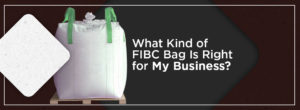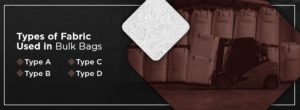
When it comes to choosing FIBC bags, you have several options, and you need to know what factors to look for to find one that’s right for your business. Size, fabric type, weight and static protection combine to help you find the ideal bags for your company. Whether you need to order bags for the first time or want to upgrade from your current storage material, this guide will help you learn everything you need to know about choosing FIBC bags for your business.
What Size FIBC Bag Do I Need?
FIBC, or flexible intermediate bulk container, is a way to store large amounts of goods such as powders or grains. You may also see these containers labeled as super bags, tote bags or bulk bags. The size of FIBC bag you will require for your operation depends on the size of the pallets you have for moving and storing the bags and the density of the material you need to store. Density is equal to the weight per cubic foot of volume. Higher densities will create heavier loads in bags of the same size compared to those with lower densities.
You need to know the weight of the material you will fill the bag with. Then, look at the safe working load (SWL) of various FIBC bags. This amount gives you the maximum weight the bag should have inside it for safe carrying and storage. However, you will also see a ratio called the safety factor (SF). This factor comes from industry standards, requiring the bag to withstand forces up to five to eight times the load inside. SF values may appear as 5:1 or 6:1.
Using the correct density value is critical to determine the right size bag you need by volume. To find the volume of an FIBC bag using density, divide the total weight of your material that you must bag by the density of the product. The answer will give you the bag volume that you will need.
For example, if you have rice flour that weighs 30 pounds per cubic foot and you must have storage for 3,000 pounds, you can use the information to find the bag volume. Divide 3,000 pounds by 30 pounds per cubic foot to find 30 cubic feet, which is the volume for the FIBC bag you need. You may want to divide the load among multiple bags if you do not have equipment that can handle a 3,000-pound FIBC bag or if you do not have pallet space for the filled bag.
Look at the base dimensions of the filled FIBC bags you order. Ensure they will fit comfortably on all pallets you have in your facility by making sure the length and width are both smaller than your pallet dimensions.
Types of Fabric Used in Bulk Bags

The fabric types used for bulk bags include varying levels of protection against static electricity:
Type A
Type A is a general-purpose material only used with products that have no chance of igniting from static electricity. Do not use this type of bag to carry anything combustible or flammable or in areas near flammable gases or products.
Type B
Bags made from type B material protect against static electricity less than 6 kV. Like type A bags, you should not use these bags around flammable gases or solvents. These bags ideally work best when carrying combustible powders but not flammable products.
Type C
Type C bags require grounding because they have a conductive material that sends any electricity directly to the ground. However, if during filling, the bags lift off the ground, they could build up a charge and cause a spark, leading to an explosion.
Type D
For extra protection against explosions without needing to ground the bags, use type D materials. These bags use a material that protects against even small amounts of explosion-causing electricity. Do not use these bags on any surface covered with a conductive material, such as water puddles or grease.
What Weight Will Be Best for My Business?
The weight of the fabric of your FIBC bags depends on what you need to carry. Denser materials will weigh more, putting extra pressure on the fabric of the bag. When you fill your FIBC bags with heavy items, you will need the containers to have heavier fabric constructions. Lighter weight fabric does not support as much, but it can save you money if you do not require heavier duty bags.
You will find fabric weights listed as either metric grams per 100 centimeters or standard ounces per square yard. The higher the fabric weight value, the stronger the bag will be. Talk to your FIBC bag seller to find the best bag weight for the materials you need to put inside.
Does My FIBC Bag Need Static Protection?
Whether your bag needs static protection is a serious concern you should have. You need to consider both the contents of the bags and where you will store them. Surrounding storage areas that pose a spark risk from static electricity or flammable substances nearby require extra protection in the FIBC bag material to prevent a fire or explosion. Many fine grains and flours are highly combustible, and protecting them from sparks could save your business and lives.
If you have flammable powders or products, use type C or D bags for static protection. Choose type B if you only need to carry combustible powders but not flammable goods. When in doubt, choose the extra static protection of type C or D bags. If you do not have flammable products or combustible goods, you may use type A bags, which do not offer any protection against sparks from static electricity.
Find the Right FIBC Bag for Your Business

If you want more information about ordering bags, contact us at Midwestern Bag or request a quote today. With our various packaging options and distribution centers across the country, we’ll surely have a high-quality packaging solution for your business.


 Copyright © 2025 Midwestern Bag. All Rights Reserved.
Copyright © 2025 Midwestern Bag. All Rights Reserved.